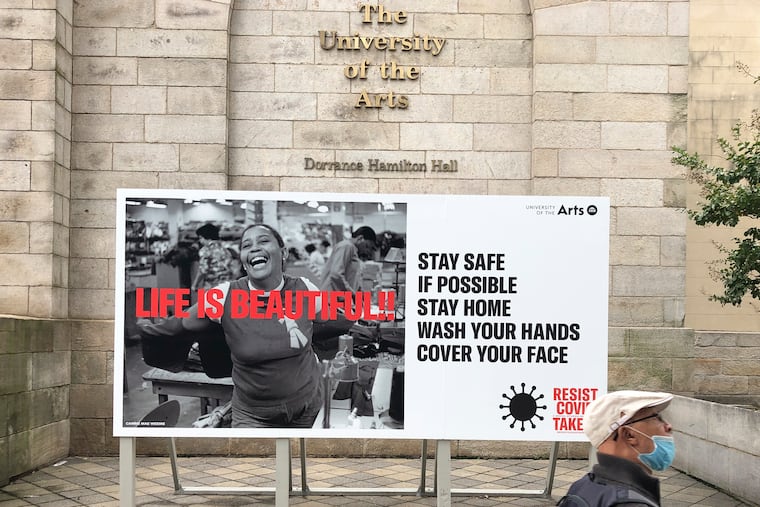Pa. won’t bring back the yellow and red shutdown phases yet, but warns against holiday gatherings
Pennsylvania reported the highest daily death toll since late June, though the death rate remains low. Murphy declared N.J. to be confronting a “second wave” as its positive test rate rose to 6.5%.

Pennsylvania officials are not currently considering returning to the color-coded shutdown phases used earlier in the coronavirus pandemic, Health Secretary Rachel Levine said Thursday, despite an unprecedented number of new infections reported this week as the fall case surge continues.
However, Pennsylvanians should not hold holiday gatherings with anyone outside their household for Halloween, Thanksgiving, Christmas, Hanukkah, or Kwanzaa, Levine said. She and New Jersey Gov. Phil Murphy both asked residents to avoid all social gatherings, parties, or dinners, which are spreading the virus.
“That’s a tremendous sacrifice that we’re asking people to make, but it is absolutely necessary,” Levine said.
The numbers of people hospitalized and dying each day in Pennsylvania — though rising — remain much lower than in the first peak of the pandemic, even though daily new infection numbers are now higher. Officials are monitoring those rates, which generally lag case numbers in climbing, Levine said.
The increasing infection numbers caused the Philadelphia School District on Thursday to say it may have to delay its plan to bring some students back to classrooms on Nov. 30, while Murphy declared New Jersey is confronting a “second wave” as the rate of people testing positive — 6.5% — exceeded epidemiologists' 5% caution threshold.
Hospitals are under stress in the Midwest, parts of Europe are going under new lockdown or watching hospital beds fill, and India, Brazil, and Russia have logged the world’s highest total case counts behind the United States, which is close to reaching nine million cases.
“The second wave of the coronavirus is no longer something that is off in the future,” Murphy said. “It is coming, and it is coming now.”
» READ MORE: Philly’s Nov. 30 back-to-school plan threatened by rising COVID-19 cases
Pennsylvania reported 2,202 newly confirmed cases on Thursday. The Health Department also reported 44 deaths, the highest number in one day since late June.
Health officials are watching the number of hospitalizations, the number of people on ventilators, the amount of stress on hospitals and need for personal protective equipment, and other indicators that show the impact of rising case numbers, Levine said. The state’s hospital system is not currently challenged.
“We are in [a] much better place than we were in the spring,” said Levine, who said the state was not considering new restrictions like those imposed in the red and yellow phases of the state’s spring shutdown.
Public health officials attribute the lower hospitalization and death rates to better medical care, access to therapeutic treatments such as the drug remdesivir, expanded testing that means not only the sickest patients are being tested, and a wider age range of patients. In the spring, a larger proportion of patients were older adults, who are more likely to have severe or fatal cases, the Department of Health said.
Levine said the state was also monitoring case numbers in relation to schools, noting that schools have local control in deciding whether to offer in-person education but that they should follow Department of Health guidance. The state recommends remote learning after an area reaches a certain rate of infection.
Though numbers are low, the state has seen a threefold increase in hospitalizations since the end of August, with more than 1,100 peoplenow admitted. And Levine said she expected the already high case counts to continue rising, which means hospitalization and death rates could do the same.
The state’s positive test rate for the 248,480 tests done in the last seven days was about 5.8% on Thursday, up from 5% at the end of last week.
Levine asked Pennsylvanians to “answer the call” to stop the spread of COVID-19 by wearing a mask, practicing social distancing, downloading the state’s COVID-19 app, and answering the phone calls of contact tracers. She said flattening the state’s transmission rate will require individual efforts from people stopping the spread within their own small circles.
“That’s how we’re going to make progress in terms of stopping the spread,” she said. “We all need to look inward and within our own families and communities, because that’s where the progress is going to lie.”
Philadelphia Health Commissioner Thomas Farley also asked city residents on Tuesday to cancel holiday plans and stay at home because of the case surge.
New Jersey reported 1,477 new cases and eight deaths. Several counties in North Jersey reported more than 100 new cases Thursday, and officials were sending a team to assist Newark with spiking cases.
Murphy also reminded residents to celebrate Halloween safely this weekend, urging revelers to wear proper masks and keep socially distanced if trick-or-treating.
“While you may wish to dress up like a knucklehead on Saturday, we don’t want anyone to act as one,” he said.
Staff writer Kristen A. Graham contributed to this article.